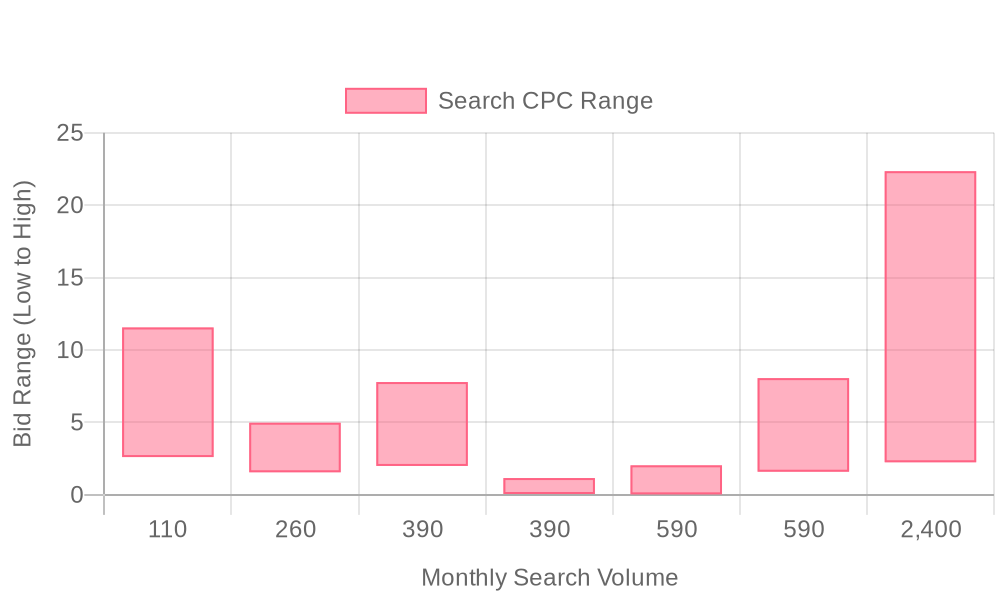
Supercharge your lead generation with a FREE Google Ads audit - no strings attached! See how you can generate more and higher quality leads
Get My Free Google Ads AuditFree consultation

No commitment
Supercharge your lead generation with a FREE LinkedIn Ads audit - no strings attached! See how you can generate more and higher quality leads
Get My Free Google Ads AuditFree consultation

No commitment
Supercharge your lead generation with a FREE Meta Ads audit - no strings attached! See how you can generate more and higher quality leads
Get My Free Google Ads AuditGet My Free LinkedIn Ads AuditGet My Free Meta Ads AuditFree consultation

No commitment
Supercharge your lead generation with a FREE Google Ads audit - no strings attached! See how you can generate more and higher quality leads
Get My Free Google Ads AuditFree consultation

No commitment
In today's competitive marketing landscape, frozen food companies face unique challenges in reaching high-intent customers while balancing online and offline marketing efforts. The battle to capture decision-makers at their point of need is intensified by untracked high-value prospects slipping through CRM systems, leading to lost opportunities. Google Ads presents a vital solution by providing the tools to identify and engage anonymous visitors, thereby converting digital visibility into actionable insights that bridge both worlds. For the frozen food industry, success lies in precise targeting and comprehensive data analysis, ensuring a strong ROI by transforming clicks into sales through strategic integration.

Frozen food companies operate in a crowded market where timing and precision determine success. High-performing revenue teams know that capturing intent-driven demand from digital channels is critical for pipeline growth and increased market share. To stay ahead, many marketers rely on advanced marketing analytics to surface the campaigns and strategies that deliver the strongest ROI.
Modern lead generation strategies for frozen food brands leverage Google Ads to identify, engage, and convert high-value prospects—often before competitors are even aware. With the right data-driven framework, marketers transform anonymous website visitors into known accounts and fill CRM pipelines with purchase-ready leads. See how one fast food business dramatically increased acquisition and ROI in this Google Ads case study.

Frozen food companies are challenged by shifting consumer preferences and fierce competition across retail and foodservice channels. Capturing attention at the exact moment of purchase intent is essential for reducing wasted ad spend and maximizing every opportunity in a crowded market. With modern Google Ads strategies, brands can precisely target buyers who are ready to act, ensuring marketing investments directly drive sales growth without overspending on low-intent audiences. For an in-depth look at how Google Ads can drive results in the food sector, review this case study on Google Ads for fast food, which highlights effective acquisition and ROI tactics.
The ability to act on high-value sales opportunities in real time is a game changer for frozen food suppliers and manufacturers. Delayed follow-up on hot leads can result in lost contracts and diminished market share. By integrating real-time intent signals, teams can swiftly route qualified leads to sales, nurturing prospects before they cool off or shift focus to competitors. This seamless flow between marketing and revenue operations helps lock in high-volume orders and strengthens client relationships.
Seasonal swings and unpredictable demand patterns are hallmarks of the frozen food sector. Dynamic, responsive Google Ads campaigns allow marketers to rapidly adjust budgets, messaging, and targeting as market conditions evolve, ensuring inventory moves efficiently and sales targets are met throughout the year. Emerging market opportunities can be identified by analyzing anonymous web traffic and visitor behavior, giving forward-thinking brands a competitive edge when expanding into new regions or launching innovative products.
Data-driven decision-making is now the standard for digital marketing in the frozen food industry. Historically, many offline conversions—such as wholesale orders initiated by phone or in-store purchases—were invisible to digital teams. Today, unified tracking and real-time attribution make it possible to capture every touchpoint, both online and offline. This complete view of the customer journey enables smarter budget allocation, campaign optimization, and ultimately, higher marketing ROI. Frozen food companies that harness these capabilities are positioned to outpace the competition and achieve sustainable growth. To see these benefits in action, get started for free with Sona.

Frozen food companies operate in a highly competitive space where digital presence drives measurable growth. Effective Google Ads strategies enable brands to reach buyers, respond to market trends, and convert interest into sales with accuracy. For a deeper look at how paid advertising drives acquisition and ROI, see this Google Ads fast food case study.
A multi-layered campaign approach ensures maximum coverage across the funnel. By aligning campaign types with specific buyer behaviors and sales cycles, marketing teams can efficiently allocate spend and boost ROI. When audience data and intent signals are unified, campaigns deliver more relevant experiences and higher conversion rates.
To see how these strategies can be tailored for your business, get started for free with Sona.

Frozen food brands are competing in a rapidly evolving market where digital visibility is essential for sustained growth. Companies that harness the full capabilities of Google Ads can precisely target high-intent buyers, streamline acquisition costs, and build measurable, scalable revenue pipelines. The most successful teams use a blend of data-driven targeting, creative digital placements, and always-on optimization to consistently uncover and convert new business opportunities. To see how digital campaigns can drive tangible results in this space, explore this case study on frozen food marketing. For more actionable strategies, visit our marketing analytics blog.

Frozen food brands that embrace granular audience segmentation in Google Ads consistently outperform generic campaigns in both engagement and conversion efficiency. By investing in data-driven segmentation, marketing teams can prioritize high-value accounts, reduce wasted ad spend, and increase ROI across diverse retail and foodservice channels.
By approaching Google Ads for frozen food companies with a sophisticated segmentation strategy, revenue teams can personalize engagement, boost advertising efficiency, and accelerate growth in a highly competitive, seasonally-driven market. The ability to unify audience data, leverage intent signals, and optimize conversion tracking transforms digital marketing for frozen foods from guesswork into a high-performance, results-driven discipline. Get started for free with Sona.

| Industry | Keyword | Monthly Search Volume | Competition Level | Low Bid | High Bid |
| Frozen Food Companies | frozen food shipping companies | 110 | MEDIUM | 2.61 | 11.56 |
| Frozen Food Companies | frozen food supplier | 260 | LOW | 1.56 | 4.98 |
| Frozen Food Companies | frozen food companies | 390 | MEDIUM | 2 | 7.79 |
| Frozen Food Companies | non dairy ice cream brands | 390 | HIGH | 0.06 | 1.16 |
| Frozen Food Companies | low carb yogurt brands | 590 | HIGH | 0.04 | 2.04 |
| Frozen Food Companies | frozen food distributors | 590 | LOW | 1.6 | 8.06 |
| Frozen Food Companies | frozen food manufacturers | 2400 | LOW | 2.25 | 22.35 |
Successful Google Ads strategies for frozen food companies start with a precise approach to keyword selection that aligns tightly with real purchase intent. High-value keywords act as the backbone for campaign structure, allowing teams to connect with audiences searching for exactly what the brand delivers—whether that is "frozen food delivery services," "bulk frozen vegetables," or "eco-friendly frozen packaging." Focusing on intent-driven terms ensures that every ad impression is more likely to reach a motivated buyer, minimizing wasted spend and raising the likelihood of conversion. For further insights on maximizing ROI from paid advertising, review this guide on food brand paid advertising, and explore our in-depth marketing analytics blog for advanced strategies.
Industry-specific keyword research must go beyond simple category terms. By layering in long-tail queries such as "organic frozen meals for restaurants" or "wholesale frozen food suppliers," marketers can tap into segments where competition is lower but purchase readiness is high. This approach captures demand from B2B buyers and procurement professionals seeking reliable partners, as well as end consumers looking for convenience and health benefits. Incorporating negative keywords is equally essential. Excluding terms that attract irrelevant clicks—such as "frozen food franchise opportunities" when selling to end users—protects budgets and improves quality scores, which directly impacts ad rank and cost efficiency.
Emerging trends in the frozen food industry, such as sustainability and direct-to-consumer delivery, present new opportunities for targeted ad campaigns. Including keywords like "sustainable frozen packaging," "carbon-neutral frozen meals," or "next-day frozen food delivery" helps brands address the interests of environmentally conscious buyers and capture emerging market share. Continuous performance analysis is critical: regularly evaluating which keywords drive the most valuable leads or sales enables marketers to quickly reallocate budget toward the highest-converting segments. Modern solutions allow revenue teams to enrich their targeting further by identifying companies and individuals visiting their site, enabling them to push these enriched audiences directly into Google Ads for precise retargeting across the funnel. This ensures that ad spend is always aligned with the most valuable and engaged prospects, driving sustained growth in frozen food sales and maximizing the ROI of every campaign. To see these strategies in action, get started for free with Sona and transform your paid search performance.
Executing a high-impact Google Ads strategy for frozen food companies requires methodical planning, precision targeting, and agile optimization. Each step in the campaign framework builds on actionable data, ensuring that marketing investments are directed at the audiences most likely to convert and drive sustainable sales growth. This approach allows B2B revenue teams to unify fragmented signals, seamlessly attribute influence, and create a streamlined digital marketing engine tailored to the evolving frozen food industry landscape. For additional strategies, explore this collection of marketing analytics insights.
Frozen food marketers see faster ROI by focusing on niche and intent-driven keyword lists. Directing attention to category-specific phrases, such as “healthy frozen meals bulk supply” or “private label frozen dinner distributors,” increases campaign relevancy and captures buyers with immediate purchase intent. Local modifiers and trending product attributes, like “organic frozen vegetables near me” or “plant-based frozen entrees wholesale,” support granular targeting while reducing wasted spend on broad, non-converting terms. Learn how an industry campaign boosted in-store engagement and sales by reviewing this frozen food shopper marketing case study.
Integrating long-tail and symptom-specific keywords, marketers can leverage precise audience intelligence to identify new high-performing opportunities as they emerge. Real-time intent signal data allows for quick adaptation, enabling dynamic reallocation of budget toward keywords linked to high-converting segments. Sona empowers marketing teams to move beyond anonymous search traffic by pinpointing which companies are actively searching for frozen food solutions, letting them prioritize resources on the most valuable accounts.
Well-crafted ad copy is essential to capture attention and convert high-intent traffic in the frozen food sector. Messaging should highlight unique value propositions, such as “flash-frozen for peak freshness” or “delivered direct, ready in minutes,” while integrating trust indicators like certifications, awards, or verified supplier credentials. Reinforcing these points with concise, actionable calls to action (e.g., “Request a quote today” or “See our full B2B range”) increases click-through rates and builds buyer confidence. For guidance on optimizing paid food advertising, see this food brand ad performance guide.
Consistency across digital and print channels ensures that messaging remains recognizable and dependable, supporting multi-touch attribution and higher conversion rates. Using performance data, marketers can continually refine headlines, offers, and trust signals to maximize engagement. Sona’s data-driven insights identify which ad variants resonate best with specific buyer segments, enabling rapid creative iteration and more personalized ad delivery throughout the decision journey.
Conversion-focused landing pages serve as the linchpin between ad spend and revenue outcomes. Every landing page element—from headline to form placement—must guide users toward a clear, frictionless action, such as “Request a Sample” or “Book a Distributor Meeting.” Incorporating high-quality product visuals, customer testimonials, and transparent pricing options reinforces credibility and addresses common buyer concerns unique to frozen food procurement. Discover digital marketing tactics that increased online orders for a frozen food retailer in this frozen food retailer case study.
Aligning landing pages with current promotions or seasonal campaigns keeps the digital experience cohesive and relevant. Marketers can synchronize page content with ad messaging for a seamless journey that minimizes drop-off and increases overall conversion rates. With advanced visitor identification, Sona enables frozen food companies to recognize returning B2B prospects or distributors, personalize landing page content in real time, and automatically route high-value leads to sales teams for immediate follow-up.
Continuous optimization is the foundation of sustained Google Ads ROI for food businesses. Smart bidding strategies, informed by conversion analytics and historical performance, allow marketers to automate bid adjustments for maximum efficiency and profitability. Dynamic audience segmentation ensures budget flows to segments exhibiting the highest likelihood of immediate purchase, while underperforming segments are deprioritized. For an in-depth analysis of Google Ads for eCommerce, review this Google Ads SaaS case study.
Ongoing optimization leverages actionable insights from both online and offline conversions, enabling holistic resource allocation across channels. Integrated attribution reveals the true impact of each touchpoint, whether a conversion occurs through ecommerce checkout, phone order, or distributor inquiry. By syncing CRM and enriched lead data with Google Ads, Sona keeps audiences and retargeting pools dynamically updated as prospects move through the funnel, ensuring spend is focused on real-time, high-value opportunities within the frozen food marketplace. To see how you can unify your digital marketing engine, get started for free with Sona.
Frozen food companies can accelerate brand authority and customer loyalty by integrating advanced Google Ads strategies with broader content marketing initiatives. Aligning retargeted educational content with ongoing campaigns supports deeper consumer engagement and positions brands as trusted resources in the competitive frozen food market. For a look at how paid advertising can drive ROI in this niche, review this frozen food Google Ads case study.
Marketers who connect with industry partners and leverage established networks unlock new channels for influence and credibility. By collaborating with associations or supply chain partners, brands extend their reach, gain third-party validation, and often access curated audience segments otherwise out of scope through account-based marketing strategies.
Localizing campaign messaging is critical for resonating in key metropolitan areas, where consumer preferences and buying patterns often differ from national trends. Adapting creative and keyword targeting to reflect local demand—such as featuring regional specialties or addressing unique dietary concerns—ensures that buying stage segmentation feels relevant and timely, driving both online and in-store conversions.
Content creation should not be static. By mining live Google Ads search query data, frozen food marketers gain actionable insight into evolving tastes, concerns, and emerging trends within their target audience. This enables teams to produce new landing pages, blog articles, or video content that directly addresses high-intent searches, building a feedback loop that sustains intent-driven retargeting and strengthens ROI.
A comprehensive approach to Google Ads for Frozen Food Companies depends on unifying campaign data, pinpointing high-intent audiences, and integrating real-time performance analytics. Solutions that identify both anonymous and known visitors allow revenue teams to dynamically update audience segments as prospects move through the funnel. When enriched audience data syncs directly to Google Ads and CRMs, marketers can retarget with precision, track conversions across channels, and attribute sales—whether online or offline—to specific campaigns. This unified view ensures frozen food brands consistently optimize for maximum impact and drive measurable sales growth across digital channels. To take the next step, get started for free with Sona.
As we conclude our exploration of Google Ads strategies for frozen food companies, it's clear that a well-crafted advertising campaign can significantly enhance brand visibility and drive sales in this competitive market. By leveraging the unique features of Google Ads, such as targeted keywords and geographic targeting, you can effectively reach your ideal customers and maximize your advertising ROI.
Throughout this article, we've delved into the core challenges faced by frozen food companies, including stiff competition and fluctuating consumer preferences. We discussed key strategies such as optimizing ad copy, utilizing display ads, and harnessing the power of remarketing to capture potential customers' attention. These solutions, when implemented thoughtfully, can set your brand apart and foster growth.
Embracing these strategies opens up a world of possibilities for your frozen food business. By making data-driven decisions and adapting to the evolving digital landscape, you position yourself for success. Remember, the right approach to Google Ads doesn't just boost visibility; it transforms your business by connecting you with the right audience at the right time.
To capitalize on these insights and elevate your advertising efforts, start for free to experience our platform and its capabilities. Here, you can access the tools and insights needed to make a significant impact in your industry.
The best strategies involve precise targeting, comprehensive data analysis, leveraging data-driven segmentation, and integrating cross-channel marketing efforts to ensure high ROI and conversion rates.
Businesses can optimize campaigns by using advanced tracking, real-time intent data, dynamic audience segmentation, data-driven optimizations, and aligning landing pages with ad messaging.
Companies should target high-intent, niche keywords such as 'frozen meal kits' or 'bulk frozen vegetables,' and incorporate long-tail queries to capture specific buyer segments.
Common pitfalls include targeting broad demographics, not leveraging intent signals, and failing to integrate campaigns with CRM and other digital channels, leading to wasted ad spend.
Success can be measured through enhanced conversion tracking, real-time attribution models, and by correlating online interactions with offline sales to get an accurate read on ROI.
Join results-focused teams combining Sona Platform automation with advanced Google Ads strategies to scale lead generation

Connect your existing CRM

Free Account Enrichment

No setup fees
No commitment required

Free consultation

Get a custom Google Ads roadmap for your business
Join results-focused teams combining Sona Platform automation with advanced Meta Ads strategies to scale lead generation

Connect your existing CRM

Free Account Enrichment

No setup fees
No commitment required

Free consultation

Get a custom Google Ads roadmap for your business
Join results-focused teams combining Sona Platform automation with advanced LinkedIn Ads strategies to scale lead generation

Connect your existing CRM

Free Account Enrichment

No setup fees
No commitment required

Free consultation

Get a custom Google Ads roadmap for your business
Join results-focused teams using Sona Platform automation to activate unified sales and marketing data, maximize ROI on marketing investments, and drive measurable growth

Connect your existing CRM

Free Account Enrichment

No setup fees
No commitment required

Free consultation

Get a custom Google Ads roadmap for your business
Over 500+ auto detailing businesses trust our platform to grow their revenue
Join results-focused teams using Sona Platform automation to activate unified sales and marketing data, maximize ROI on marketing investments, and drive measurable growth

Connect your existing CRM

Free Account Enrichment

No setup fees
No commitment required

Free consultation

Get a custom Google Ads roadmap for your business
Over 500+ auto detailing businesses trust our platform to grow their revenue
Join results-focused teams using Sona Platform automation to activate unified sales and marketing data, maximize ROI on marketing investments, and drive measurable growth

Connect your existing CRM

Free Account Enrichment

No setup fees
No commitment required

Free consultation

Get a custom Google Ads roadmap for your business
Over 500+ auto detailing businesses trust our platform to grow their revenue
Our team of experts can implement your Google Ads campaigns, then show you how Sona helps you manage exceptional campaign performance and sales.
Schedule your FREE 15-minute strategy sessionOur team of experts can implement your Meta Ads campaigns, then show you how Sona helps you manage exceptional campaign performance and sales.
Schedule your FREE 15-minute strategy sessionOur team of experts can implement your LinkedIn Ads campaigns, then show you how Sona helps you manage exceptional campaign performance and sales.
Schedule your FREE 15-minute strategy sessionOur team of experts can help improve your demand generation strategy, and can show you how advanced attribution and data activation can help you realize more opportunities and improve sales performance.
Schedule your FREE 30-minute strategy sessionOur team of experts can help improve your demand generation strategy, and can show you how advanced attribution and data activation can help you realize more opportunities and improve sales performance.
Schedule your FREE 30-minute strategy sessionOur team of experts can help improve your demand generation strategy, and can show you how advanced attribution and data activation can help you realize more opportunities and improve sales performance.
Schedule your FREE 30-minute strategy sessionOur team of experts can help improve your demand generation strategy, and can show you how advanced attribution and data activation can help you realize more opportunities and improve sales performance.
Schedule your FREE 30-minute strategy session





Launch campaigns that generate qualified leads in 30 days or less.
